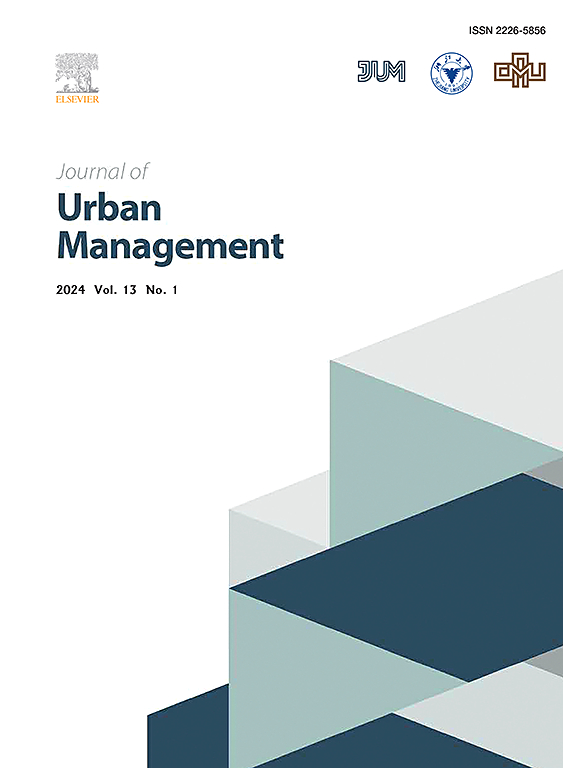Unveiling the building embodied carbon dynamics in Yangtze River Delta: Spatial and life cycle perspectives
IF 5
2区 社会学
Q1 URBAN STUDIES
引用次数: 0
Abstract
Understanding and reducing the greenhouse gas emissions from building sector is significant to realize the net zero society. This research presents a bottom-up approach leveraging nighttime light (NTL) data to quantitatively assess and spatially represent urban building Material Stock (MS) and Embodied Carbon Emissions (ECE) throughout the “cradle-to-gate” lifecycle, at the micro-unit level, within the rapidly urbanizing Yangtze River Delta (YRD) region. Our primary focus is on investigating the dynamics and evaluating the impacts of building material stocks and the associated embodied carbon under urban expansion. Key findings include: (1) From 2000 to 2020, the YRD experienced a significant increase in building MS, with development expanding more rapidly along the southeast-northwest axis than the southwest-northeast axis. (2) Building ECE grew markedly in the YRD, especially in coastal areas, shifting from a concentrated single-center pattern to a multi-center one. The growth trends of building ECE among these cities varied widely, ranging from 0.64 to 85.71 Tg per year (Tg/a). (3) Construction materials such as sand, gravel, cement, and brick dominated the MS in both residential and non-residential buildings. Cement, steel, brick, and aluminum were the main contributors to building ECE. Notably, despite their lower volumes, copper and aluminum had substantial environmental impacts due to their high ECE contributions. (4) By categorizing cities into four types based on ECE per capita and growth trends, we identified varied urban development and environmental impacts across the YRD.
揭示长三角建筑碳动态:空间与生命周期视角
了解和减少建筑行业的温室气体排放对实现净零社会具有重要意义。本研究提出了一种自下而上的方法,利用夜间照明(NTL)数据,在快速城市化的长江三角洲(YRD)地区的微单元层面上,定量评估城市建筑材料库存(MS)和隐含碳排放(ECE)在“摇篮到门”整个生命周期中的空间分布。我们的主要重点是调查动态和评估建筑材料库存和相关隐含碳在城市扩张下的影响。结果表明:(1)2000 - 2020年,长三角地区建筑MS显著增加,且沿东南-西北轴的发展速度大于西南-东北轴的发展速度。(2)长三角地区,特别是沿海地区,欧洲经济共同体建设显著增长,由集中的单中心模式向多中心模式转变。这些城市建设ECE的增长趋势差异很大,从每年0.64 - 85.71 Tg (Tg/a)不等。(3)住宅和非住宅建筑的MS均以砂、砾石、水泥、砖等建筑材料为主。水泥、钢铁、砖和铝是建造欧洲经委会的主要贡献者。值得注意的是,尽管铜和铝的产量较低,但由于它们对欧洲经委会的贡献很大,对环境产生了重大影响。(4)根据欧洲经济委员会的人均水平和增长趋势,我们将城市分为四类,确定了长三角地区不同的城市发展和环境影响。
本文章由计算机程序翻译,如有差异,请以英文原文为准。
求助全文
约1分钟内获得全文
求助全文
来源期刊

Journal of Urban Management
URBAN STUDIES-
CiteScore
9.50
自引率
4.90%
发文量
45
审稿时长
65 days
期刊介绍:
Journal of Urban Management (JUM) is the Official Journal of Zhejiang University and the Chinese Association of Urban Management, an international, peer-reviewed open access journal covering planning, administering, regulating, and governing urban complexity.
JUM has its two-fold aims set to integrate the studies across fields in urban planning and management, as well as to provide a more holistic perspective on problem solving.
1) Explore innovative management skills for taming thorny problems that arise with global urbanization
2) Provide a platform to deal with urban affairs whose solutions must be looked at from an interdisciplinary perspective.
 求助内容:
求助内容: 应助结果提醒方式:
应助结果提醒方式:


